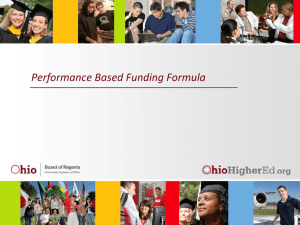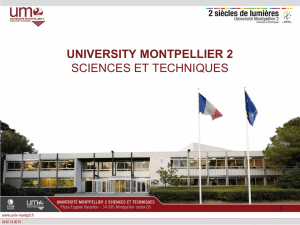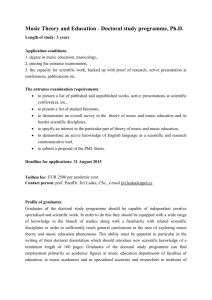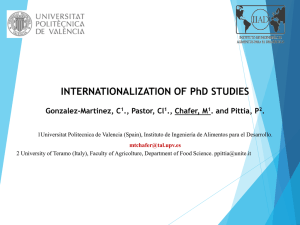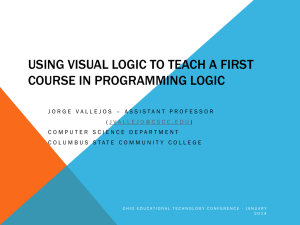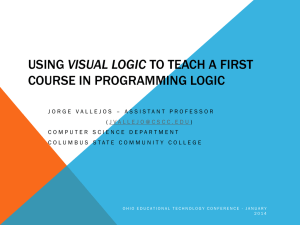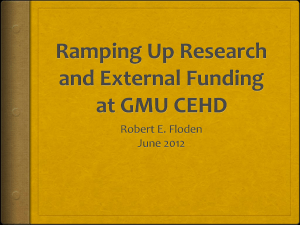A Funding Formula for Ohio`s Universities
advertisement
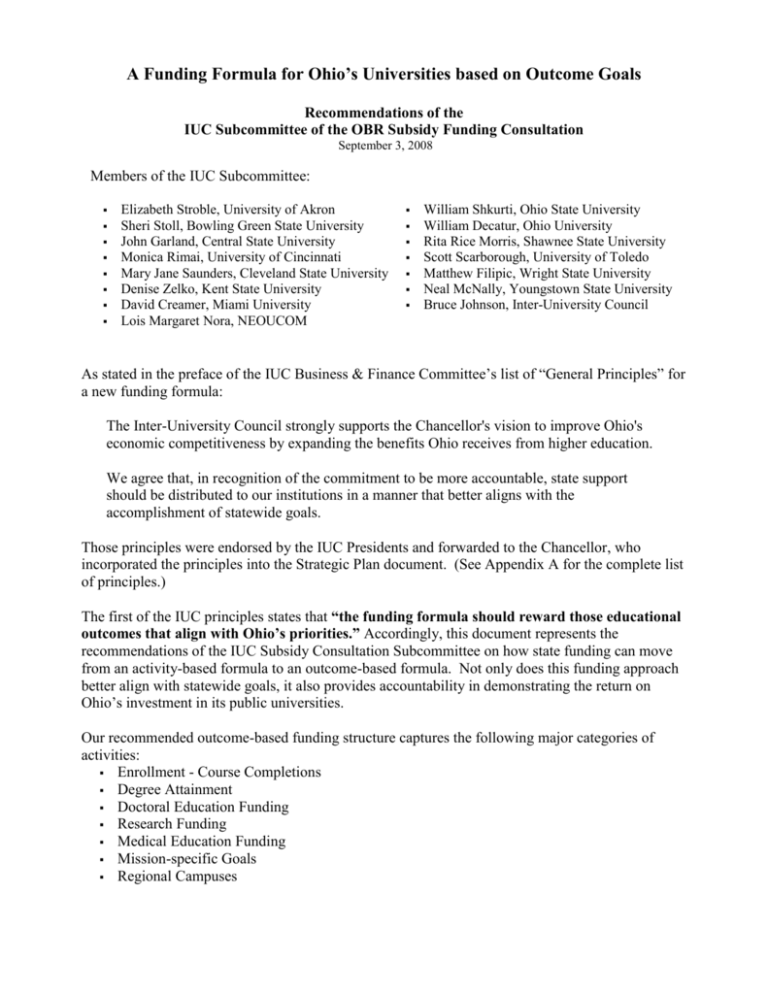
A Funding Formula for Ohio’s Universities based on Outcome Goals Recommendations of the IUC Subcommittee of the OBR Subsidy Funding Consultation September 3, 2008 Members of the IUC Subcommittee: Elizabeth Stroble, University of Akron Sheri Stoll, Bowling Green State University John Garland, Central State University Monica Rimai, University of Cincinnati Mary Jane Saunders, Cleveland State University Denise Zelko, Kent State University David Creamer, Miami University Lois Margaret Nora, NEOUCOM William Shkurti, Ohio State University William Decatur, Ohio University Rita Rice Morris, Shawnee State University Scott Scarborough, University of Toledo Matthew Filipic, Wright State University Neal McNally, Youngstown State University Bruce Johnson, Inter-University Council As stated in the preface of the IUC Business & Finance Committee’s list of “General Principles” for a new funding formula: The Inter-University Council strongly supports the Chancellor's vision to improve Ohio's economic competitiveness by expanding the benefits Ohio receives from higher education. We agree that, in recognition of the commitment to be more accountable, state support should be distributed to our institutions in a manner that better aligns with the accomplishment of statewide goals. Those principles were endorsed by the IUC Presidents and forwarded to the Chancellor, who incorporated the principles into the Strategic Plan document. (See Appendix A for the complete list of principles.) The first of the IUC principles states that “the funding formula should reward those educational outcomes that align with Ohio’s priorities.” Accordingly, this document represents the recommendations of the IUC Subsidy Consultation Subcommittee on how state funding can move from an activity-based formula to an outcome-based formula. Not only does this funding approach better align with statewide goals, it also provides accountability in demonstrating the return on Ohio’s investment in its public universities. Our recommended outcome-based funding structure captures the following major categories of activities: Enrollment - Course Completions Degree Attainment Doctoral Education Funding Research Funding Medical Education Funding Mission-specific Goals Regional Campuses IUC Funding Subcommittee Recommendations for Funding Formula September 3, 2008 page 2 of 20 [Refer to Appendix B for a diagram of the conceptual model, showing distribution of funding by goal/outcome category.] QUALITY In all areas of teaching, research and community outreach, Ohio’s public universities continually seek to improve and excel. Woven throughout all our work is the priority to guide, assist and encourage students through their coursework to successful completion of their degree program. Quality programs are needed to respond flexibly to the individual needs of a diverse population of students. General Principle 5 states that “the funding formula should recognize the value added by public colleges and universities that prepare and graduate at-risk students.” To capture this value, we recommend that the funding formula include a “Quality” component that recognizes Ohio students who are identified as “at risk” academically or socio-economically and, above expectations, successfully complete courses and graduate. The Board of Regents’ HEI system is not currently designed to collect all student data needed to accurately identify students with what would be considered as risk factors. Agreed-upon standards need to be established so that all institutions are using the same definitions and applying the same measures (e.g., definition for “developmental” courses). We recommend that OBR and institutions work together to identify the risk factors that will be used, develop system-wide standards/definitions, and then collect the student data that will appropriately identify at-risk students. In the interest of transitioning to an outcomes-based formula, we recommend that the most appropriate indicator currently available for academically/economically at-risk students is Ohio Instructional Grant / Ohio College Opportunity Grant (OIG/OCOG) eligibility – which was used in the distribution of Success Challenge. More precise identification of at-risk students will occur as new measures are developed. ENROLLMENT – COURSE COMPLETIONS To demonstrate the persistence of our students in working toward a degree, we recommend that enrollments should be funded based on course completions (grade D or higher) and by statewide average cost of program using the new SSI taxonomy. This is a major shift from the current funding formula that is based on 14th day enrollment reports. Undergraduate students should be weighted by: Expected completion rate – based on course completion rates at each campus, by discipline area (seven categories) and by subsidy level (developmental, general studies or technical, and baccalaureate); IUC Funding Subcommittee Recommendations for Funding Formula September 3, 2008 page 3 of 20 OIG/OCOG eligibility – based on the statewide average for each discipline area and level (comparison of traditional students’ course completion rates to OIG/OCOG eligible student course completion rates). As noted above, more precise measures and weights will be applied as they are developed. Masters and Professional (Non-medical) students should be funded based on course completion only, and on statewide average cost of program (new SSI taxonomy), but not weighted for OCOG eligibility or other risk factors. Note: Enrollment funding will continue to be based on data from one year prior, and on the greater of the two-year or five-year averages. DEGREE ATTAINMENT As stated in the Strategic Plan, “Graduating people is the core business of higher education.” To demonstrate the success of our students in completing their program studies and earning their degrees, we recommend a shift from funding based predominantly on enrollments to a portion of the State Share of Instruction (SSI) funding allocated based on the number of baccalaureate, master and doctoral degrees awarded. (Note: Associate degrees will also be rewarded at Central State University, Shawnee State University, and the two-year components on the main campuses of the University of Akron, University of Cincinnati, Cleveland State University and Youngstown State University, in recognition of their role as Access institutions.) Undergraduate – A growing component of university funding should be determined by number of degrees awarded, with weights added to account for: the statewide average cost established by OBR for each degree program; the actual vs. predicted graduation rate of each graduating student, to align funding with the USO goal of increasing the number of college graduates among those students less likely to graduate. At this time we recommend use of OIG/OCOG eligibility as the at-risk indicator, until more precise measures are developed. OBR will compare graduation rates for OIG/OCOG-eligible students to non-eligible OIG/OCOG students, to determine the appropriate added weight for graduating at-risk students. Degrees attained by transfer students should be fully funded – the degree-granting institution would receive 100% credit for each student that successfully completed a baccalaureate program. Masters and Professional (non-medical) – Funding should be based on degrees awarded, using the average cost of the degree program (new SSI taxonomy) only. We recommend that Success Challenge be rolled into the overall main campus sector appropriation as the degree-attainment goals of Success Challenge are now reflected in the proposed core funding formula. OBR staff has correctly noted that Success Challenge and tuition subsidy funds are currently targeted for undergraduate education. Therefore, we recommend the proposal put forth by OBR staff that reduces the weight for graduate education in the new SSI taxonomy so that base IUC Funding Subcommittee Recommendations for Funding Formula September 3, 2008 page 4 of 20 funds currently allocated for Success Challenge and tuition subsidy will continue to support undergraduate education. DOCTORAL EDUCATION and RESEARCH FUNDING We recommend a funding formula for doctoral education and research programs that is supportive of the goals of the Strategic Plan. Our suggested approach is to gradually shift away from the current set shares within the doctoral set-aside (which have been held to a static percentage of SSI based on mid-1990s enrollment levels) to a more dynamic allocation based on three major factors: Research grant activity Other quality measures Degrees awarded 25% at 10th year (use Research Incentive Program measures*) 25% at 10th year (measures to be developed by IUC Provosts) 50% at 10th year (weighted by average statewide cost of program) Beginning in FY2010, 90% of funding would be allocated based on existing doctoral shares, 10% on the proposed new formula (above). Each fiscal year there would be an additional 10% shift from the old to new formula. Measures would be based on a university’s entire portfolio, not by each doctoral program individually. Each institution would determine allocation within its programs. Research Incentive and Technology Innovation and Enhancement (TIE) Grant Programs should remain as separate components outside of this formula, for now. *We recommend that NIH grants should be weighted at 50% to reflect the degree to which NIH research is also supported through the medical education model. Note: We suggest that the IUC Provosts explore the impact of this recommendation, and determine what adjustment might be applied to properly account for NIH grants awarded to institutions with no medical school. [See Appendix C “Funding for Doctoral Education and Research” for a more detailed recommendation.] MEDICAL EDUCATION FUNDING The Medical Deans were convened for their input and ideas into potential changes to medical education funding. There was thoughtful and robust discussion relevant to all facets of the current medical education funding model, in which various ideas related to changing the model were deliberated. In summary, their consensus recommendations were that: Each line item in support of medical education should remain separate and distinct, as they each have a unique and distinct purpose; some are required due to statutory mandate, and some are already distributed based on preferred outcome measures. The Clinical Teaching subsidy could be distributed in accordance with methodologies outlined for the General Assembly in 2006, which reward collaborative efforts and partially revise distribution based on FTE, if additional clinical teaching funding were made available. IUC Funding Subcommittee Recommendations for Funding Formula September 3, 2008 page 5 of 20 SSI should continue to be distributed based on FTE enrollments, as other factors such as course completion cannot be appropriately applied to medical curriculums. Base enrollments or “caps” have increasingly been identified as an issue due to healthcare needs of the state and enrollment trends over the years, and should be evaluated further, especially if additional funds were made available for medical education. Such an evaluation would take longer than this current subsidy consultation will allow, and therefore should be conducted throughout the upcoming months. While the distribution of medical education funds could be made more equitable, all of the schools agree that this should not be done by further reducing funding for any of them. [Note: See a more detailed meeting summary document (Appendix D) and associated attachments (separate documents) for further information and clarification.] Degree Attainment – We agree with the IUC Medical Deans that course completion rates should not be used to distribute medical education funding due to the structure of the medical curriculum. We would, however, suggest that there be some consideration of degree attainment rates as part of the overall funding formula for medical education. Medical Education Funding Consultation - We recognize that the current line items for medical education meet a separate and distinct purpose, and that some are already distributed based on outcome measures. We suggest that a more holistic look at medical education funding be undertaken, recognizing that such a comprehensive study would require a longer timeline than the current subsidy consultation will allow. We therefore recommend that a separate consultation specific to medical education funding be conducted over the next biennium, resulting in recommendations to optimize the alignment of medical funding models with the educational and economic development goals of the Chancellor’s Strategic Plan. Medical Enrollment and Buffering – The medical school deans and the IUC fiscal officers discussed the current base enrollment and buffering practice and the majority feel any potential change to the current buffering process should be studied as part of the recommended medical education funding consultation over the next biennium. A subgroup of medical school deans and business officers would be willing to explore a creative adjustment to base enrollments – in light of enrollment changes over the years since this system was implemented – and quality of the outcomes. Veterinary and Dentistry (Med 1) – There is consensus that Veterinary and Dentistry (OSU programs classified as “Med 1” in the SSI taxonomy model) should be included in the Medical Education funding category. These two programs are more appropriately funded based on enrollments and not according to course completions or degree attainment. This may be a shortterm solution, subject to deliberation in the proposed medical education funding consultation. MISSION-SPECIFIC GOALS The third IUC general principle for a funding formula stated that “the funding formula should reward not only the teaching mission of all colleges and universities to enroll and graduate IUC Funding Subcommittee Recommendations for Funding Formula September 3, 2008 page 6 of 20 students but other contributions to Ohio’s economy such as research, technology transfer, workforce development and community revitalization.” We therefore recommend that a portion (5-10%) of funding for each university should be set aside for mission-specific goals, to be determined through negotiation between each institution and the Chancellor. The goals identified by each university may focus on increasing access and participation by a targeted population; providing a program or service that addresses local community or industry needs; developing new learning technologies that better serves its students; or a variety of other activities unique to each campus’ strengths and mission, and the area of the state that it serves. Campus efforts to run more streamlined operations are important goals that should be recognized and rewarded. Shared services and other multi-institutional collaborations that lead to increased efficiencies or cost savings, and/or improved service delivery, should also be encouraged and rewarded. Identification of institutional mission goals should be linked to benchmarks/metrics established by each university, to measure progress toward goals. Institutional funding could range from 70-130% of the annual set-aside, dependent on progress and attainment of goals. Within the Mission-specific Goals category, the following funding should continue to be earmarked for specific institutions, using FY09 allocations as a baseline: Access Challenge funding to four-year institutions and regional campuses Central State Supplement Shawnee State Supplement These earmarks will be incorporated within this category of the model but will not be at risk. (Note: Access Challenge funding should not be at risk in FY10-FY11, but this may be reconsidered in subsequent budget years.) REGIONAL CAMPUSES Our 24 regional campuses provide an increasingly vital pathway for students to university baccalaureate programs. They play an important access role for under-served, under-prepared populations seeking affordable and geographically convenient entry points to higher education. Due to the distinct access and pathway roles of the regional campuses, the degree-attainment aspect of the model proposed for main campuses would not appropriately address those missions at this time. We recommend a separate appropriation of SSI funding for the regional campuses. For the next two biennia (FY2010-FY2011, FY2012-FY2013) these funds should be allocated entirely by enrollments based on course completions, weighted for at-risk students as identified by OIG/OCOG eligibility. As regional campuses shift their mission toward more complete baccalaureate program offerings, in alignment with the goals of the Strategic Plan for the next ten years, some portion of allocation based on degree attainment may be appropriate. We recommend a category for “Mission-specific Goals” for regional campuses that contains the Access Challenge funding, which addresses the access mission of all our regional campuses. This IUC Funding Subcommittee Recommendations for Funding Formula September 3, 2008 page 7 of 20 funding would continue to be allocated to campuses in FY2010-FY2011 following FY2009 distributions as a baseline. A change in allocation of Access Challenge may be appropriate in subsequent years. Note: The Regional Campus appropriation includes the total FY2009 allocations of SSI to all regional campuses and to OSU’s Agricultural Technical Institute (ATI). ATI should be included and funded within the regional campuses model. STABILITY Our eighth general principle states that “the funding formula should be designed to provide some level of predictability and financial stability for institutions.” We therefore recommend that a 99% stop-loss be applied in FY2010, and 98% in FY2011, to provide some stability while universities make the necessary changes to more directly align with the Strategic Plan goals. NON-FORMULA FUNDING RECOMMENDATIONS “2 to 4” Transfers Reward We recommend new funding in a separate line item, outside the formula, to equally reward (regardless of division of credit hours) both sending and receiving schools for students that transfer into a university and go on to successfully complete a baccalaureate degree program. The reward program should apply to students transferring out of any Ohio public community, technical or regional campus into any Ohio public university – including students who transfer from a regional campus to the main campus within the same university. This recommendation aligns with the Chancellor’s encouragement of a “2+2” program – offering a more affordable option for students to obtain a bachelor’s degree. Centers of Excellence The Strategic Plan calls for the universities to work with the Chancellor in identifying Centers of Excellence within our campuses, and set goals for those centers that together “guarantee a range of academic strength sufficient to drive the global competitiveness of Ohio’s economy (Strategic Plan, page 24).” In recognition and support of this key strategy, we recommend new funding in a separate line item for the Chancellor to reward and strengthen the work of these Centers of Excellence. See Appendix E for suggested identification and performance measures, developed by the IUC Provosts Committee. IUC Funding Subcommittee Recommendations for Funding Formula September 3, 2008 page 8 of 20 AFFORDABILITY Universities constantly strive to hold down the cost for students to attend college, regardless of their ability to pay. At the same time, institutions must balance the limited resources available through state funding and tuition to provide a high quality education, with essential support services, and a safe and positive campus environment that students and parents demand. The Strategic Plan asserts that Ohio’s public universities should be given greater flexibility to set tuition policies so that they can better address both affordability and quality. We wholeheartedly support that approach. Beginning this year, each university will submit to the Chancellor a biennial report with a prospective tuition plan that is tied to the ability of all students to pay the “net” cost of attendance – determined from available federal, state, and institutional financial aid. To help convey a clearer picture of the actual or “net” cost of tuition and fees, each IUC institution will calculate and report the information detailed below. Reports are to be submitted to the IUC office and compiled for review by IUC Presidents at their September 9, 2008 council meeting. We anticipate that this information will then support efforts to link affordability with tuition flexibility. A. Average freshman tuition and fees paid in 2007-08, based on the following definitions: Students First-time, full-time subsidy-eligible dependent freshmen in FY2008 (fall term, annualized) Include: Main campuses only Exclude: regional campuses and independent students (to be addressed, separately) Costs Include: tuition, general fees, books and supplies (excluding computers – too much variance in campus policies) – each institution to report average cost of books & supplies; OBR to determine overall statewide average Exclude: room & board, meals, transportation, other living expenses; first-time, one-time fees (e.g. admissions, orientation, freshman experience class) B. Percentage of students who receive any financial aid using the following definitions – Income Categories 1. $0 EFC 2. $1 EFC→ OCOG eligibility 3. OCOG eligibility +$1 → Pell Grant eligibility 4. Pell Grant eligibility +$1 and above in $5,000 increments to $100,000 Gift Aid (report in the following three groups): 1. Federal grant aid 2. State grant or scholarship 3. Institutional aid (a) Internal revenues – including merit aid, need-based aid, athletic scholarships, employee and dependant tuition waivers IUC Funding Subcommittee Recommendations for Funding Formula September 3, 2008 page 9 of 20 (b) External revenues – scholarships from gifts or endowments to the institution (as defined by HEI Financial Aid unit data definition), including grants such as Choose Ohio First, NSF, etc. Note: Exclude 3rd party aid or aid for which the institution does not determine recipient (e.g., employer payment/reimbursement, club scholarships, etc.) IUC Funding Subcommittee Recommendations for Funding Formula September 3, 2008 page 10 of 20 Appendix A University System of Ohio Funding Model Principles Preface The Inter-University Council strongly supports the Chancellor's vision to improve Ohio's economic competitiveness by expanding the benefits Ohio receives from higher education. We agree that, in recognition of the commitment to be more accountable, state support should be distributed to our institutions in a manner that better aligns with the accomplishment of statewide goals. We believe that if the new funding formula is driven by the principles that are listed below, the educational outcomes from state spending on higher education will increase and the economic outlook for Ohio will be greatly improved. General Principles 1. The funding formula should reward educational outcomes that align with Ohio’s priorities (e.g., degrees granted). 2. The outcomes that are rewarded should take into consideration differences in institutional missions, including differences between the two-year and four-year sector and differences among four-year institutions, and provide appropriate levels of state support for each mission. 3. The funding formula should reward not only the teaching mission of all colleges and universities to enroll and graduate students but other contributions to Ohio’s economy such as research, technology transfer and workforce development. 4. The funding formula should recognize differences in the cost of academic programs when funding educational outcomes or enrollments. 5. The funding formula should recognize the value added by public colleges and universities that prepare and graduate at-risk students. 6. Success in meeting Ohio’s goals to enroll and graduate more students should not come at the expense of higher tuition or lower quality educational experiences for existing students. Increases in enrollment and degrees awarded that advance state goals should be supported by appropriate increases in state funding. 7. The funding formula should clearly recognize the inverse relationship between state support and tuition. 8. The funding formula should be designed to provide some level of predictability and financial stability for institutions. IUC Funding Subcommittee Recommendations for Funding Formula September 3, 2008 page 11 of 20 9. The funding formula should incorporate and reward specific outcomes that may be of an immediate priority for Ohio when these incentives are funded, such as the need for additional STEM or nursing graduates. 10. The details of the funding formula should be the outcome of an open consultative process with multi-institutional input. Open Questions 1. With an increased emphasis on attracting talent to the state economy, should degrees awarded to non-Ohioans be rewarded especially if the graduate remains in Ohio? 2. We must be cognizant of the relationship between the operating and capital budgets, and between the capital budget and the goals and metrics of the University System of Ohio. How will deferred maintenance needs and classroom/laboratory obsolescence be addressed? 3. How will transitional issues, such as the phase out of old programs and the phase in of new programs, be addressed under the new funding structure? IUC Funding Subcommittee Recommendations for Funding Formula September 3, 2008 page 12 of 20 Appendix B CONCEPTUAL MODEL - University Main Campus Sector Year Enrollment Goals1 Degree Attainment2 Quality Measures3 Mission Specific Goals4 FY10 91.06% 5.36% 1.97% 1.61% FY11 TBD 10% FY12 TBD 15% FY13 TBD 20% Earnings from OIG/OCOG weights Earnings from OIG/OCOG weights Earnings from OIG/OCOG weights Doctoral Research Medical Clinical “2 to 4” Transfers Centers of Excellence 10% (90%-110%) 10% (80%-120%) 10% (70%-130%) CONCEPTUAL MODEL – University Regional Campus Sector Year Enrollment Goals FY10 100% FY11 100% FY12 100% FY13 100% 1 Quality enrollment earnings from OIG/OCOG weights enrollment earnings from OIG/OCOG weights enrollment earnings from OIG/OCOG weights enrollment earnings from OIG/OCOG weights Mission-specific Goals Access Challenge Access Challenge Access Challenge Access Challenge 1 Course completions weighted for average cost of degree program using new SSI taxonomy. One-year lag; apply 2year/5-year averages. 2 100% credit to degree-granting institution; weight for average cost of degree program. 3 Course Completions – quality component: weight for OCOG eligibility; Degree Attainment – quality component: weight for actual vs. expected rate (in transition, apply expected 1 st year retention rate for first 3 years, then move to grad rate). 4 In FY09 each institution will work with the Chancellor to establish agreed-upon goals and set benchmarks. Beginning in FY10 and each year thereafter, the Chancellor will determine MSG funding based on goals/benchmarks met. Percentages in parentheses indicate the maximum cut/increase in funding a campus may experience within MSG funding. Earmarks included in this category will be Access Challenge ($4.28M for main campuses in FY09), SSU supplement ($2.58M in FY09) and Central State supplement ($12.11M in FY09). These earmarks will be incorporated within this category of the model but will not be at risk. (Access Challenge funding will not be at risk in FY10-FY11; to be reconsidered in subsequent budget years). IUC Funding Subcommittee Recommendations for Funding Formula September 3, 2008 page 13 of 20 Appendix C Funding for Doctoral Education and Research July 15, 2008 Background Prior to 1998, doctoral programs were funded on an enrollment basis as were all other programs. But there was a growing concern that the very high marginal rates of subsidy per FTE provided by the formula (without an enrollment cap that accompanied the high marginal rates provided in the medical models) created an incentive for campuses to grow doctoral enrollments in ways inconsistent with academic values or state needs. In response, the state uncoupled doctoral funding from enrollments. A fixed share of the State Share of Instruction was earmarked for doctoral education, with that amount allocated among campuses on the basis of historical enrollments in the mid 1990’s. As long as a campus’s doctoral enrollments did not fall below 85% of that historical base, its share of doctoral funding would not be affected by enrollment fluctuations. The state hoped that this uncoupling of funding from enrollments would allow campuses to manage their doctoral programs in a way that fostered quality rather than simply volume. While the new state approach had this advantage, it also had the disadvantage that it was no longer responsive to changes in the doctoral programs at our several universities. A general advantage of formula funding is that it is responsive to changes in the variables that drive the formula. As time passes, it is increasingly important that the distribution of funding for doctoral programs across campuses be tied to something other than historical shares of funding in the mid 1990’s. One attempt to reintroduce some dynamism into doctoral funding came out of the work of the Governor’s Commission on Higher Education. The Innovation Incentive concept was that each university would develop a plan to reallocate support among its doctoral programs in ways designed to enhance contributions to state needs. The state would add funding in amounts equal to the required reallocations. Over time, the basis for allocating this enhanced funding would shift from historical shares of doctoral funding to shares of research grant activity. However, the increased state funding that was expected in the 2008-9 biennium did not materialize. Instead new funding was focused on the Ohio Research Scholars program. This was a bold attempt to increase state support for research faculty, but it did not specifically address funding for doctoral programs. Proposal Given this background, our subcommittee examined approaches to making state funding for doctoral programs more supportive of the goals of the strategic plan for the University System of Ohio. In crafting a new formula for funding doctoral programs, we recognized that it would be impossible to find one that worked equally well to address the unique characteristics of each program. Our goal was more modest – to develop an approach that reasonably reflected and rewarded the size and quality of an institution’s portfolio of programs, recognizing that it would be IUC Funding Subcommittee Recommendations for Funding Formula September 3, 2008 page 14 of 20 necessary for institutional budget processes to reallocate funds to programs whose strength might not be adequately recognized in the state funding model. The plan we developed would involve a gradual shift – over a ten year period - away from the shares of funding determined by shares of historical doctoral enrollments to an allocation based on three major factors: Research Grant Activity, using data collected and published by the National Science Foundation, but weighting NIH funding by a factor of 50 percent. The weighting of this life sciences research is recommended because this research is arguably a product of both doctoral and medical school funding, whereas other areas of research are more closely related to doctoral programs alone. [We would not recommend a similar weighting in the Research Incentive program, since its purpose is the encouragement of funded research and not the funding of doctoral programs.]. Over time, we would move to a goal of allocating 25% of doctoral funding on the basis of weighted Research Grant Activity. This component of the formula would provide a strong incentive for campuses to nurture programs that were successful in attracting research grants. Degrees awarded, weighted by the cost of the programs. Over time, this would drive 50% of doctoral funding. This shift from the historical enrollment base would provide incentives for completion of degree programs and avoid the problems formerly experienced in determining how to translate dissertation work into an FTE base. The subcommittee wishes to see the final fourth of doctoral funding allocated on the basis of other measures of quality. However, we were unable to identify measures that might be suitable in the time available. Because we continue to believe that measures of program quality in addition to research productivity should be incorporated into doctoral program funding, we recommend that the academic leadership of our campuses be engaged to develop an approach that would, over time, allocate 25% of doctoral funding on the basis of quality measures. Since doctoral funding is so substantial, campuses will need time to adjust to a different logic for allocating these funds. The group suggested that the state make this transition over a ten year period. In the first year, 90% of the doctoral funding would be allocated on the basis of existing doctoral shares, while the remaining 10% would be allocated on the basis of the formula described above. In each succeeding year, the portion allocated on the basis of current doctoral shares would be reduced by ten percent and that amount would be added to the formula allocation. These recommendations focus on the alternatives to the current funding of doctoral programs and not on the different but related question of fostering the economic contributions of our campuses through research and development activities. This area has seen a new emphasis in the current biennium, with substantial new programs being implemented for the first time. We support these initiatives and believe that they deserve additional time to demonstrate their worth before any suggestions are made to modify them. Clearly, the allocation of funding through this proposed formula needs to be tested with some modeling. While the focus of our conversation was on the reallocation of shares of the current “pot” IUC Funding Subcommittee Recommendations for Funding Formula September 3, 2008 page 15 of 20 of doctoral program support, the same formula elements could over time serve to drive changes in the total amount of doctoral support provided by the state. The three major categories of proposed doctoral funding are intended to acknowledge different aspects of doctoral programming that deserve state support. We need to determine how well the proposed approach might do this. In answering this question, we should not feel compelled to demonstrate that the approach works well for each individual doctoral program in the state. Surely, it will always be possible to identify a particular program whose claim on state support is reflected neither in research funding nor perhaps in other measures of quality that might be developed. Identifying such a program should not lead us to reject this new approach; no formula is likely to be able to properly assess and reward the quality of each individual program. A more reasonable test for this or any alternative funding approach is whether it reasonably supports each institution’s portfolio of doctoral programs. If a new funding approach provides a campus’s academic leaders with an amount of funds reasonably related to the size and quality of its doctoral programs while creating strong incentives for increased quality over time, it will have done enough. Filipic, Plummer, Rimai, and Shkurti 7/15/2008 IUC Funding Subcommittee Recommendations for Funding Formula September 3, 2008 page 16 of 20 Appendix D Summary of Ohio Council of Medical Deans Meeting Friday, June 27, 2008 Background and Summary: Chancellor Eric Fingerhut convened the 2008 Subsidy Consultation to begin implementation of a key element of his”Strategic Plan for Higher Education: 2008-2017”, namely, to align the state’s funding of higher education with the goals of the plan. On Friday, June 27, 2008, the Council of Medical Deans, along with key financial administrators and governmental relations staff members from Ohio’s medical colleges, came together to discuss Medical Model II funding and provide feedback to the consultation relative to the current state budget line items for medical education. After a brief introduction on the consultation’s charge and progress to date, a discussion ensued related specifically to each individual medical education line item. Discussion centered primarily on those line items specifically in support of the six public medical schools. Overall, the Council is in agreement that each line item in support of medical education should remain separate and distinct, for various reasons outlined later in this document. Each medical line item was created with a definitive purpose with specific objectives and goals in mind to support various facets of medical education. Some, like Family Practice and Geriatric Medicine, are required due to statutory mandate. Therefore, there was overall consensus that the purpose of each line item not be lost by a consolidation or pooling of medical education funding. In addition, in recent years the medical education line items have been discussed repeatedly within the context of each new biennial operating budget. It was noted that conclusions regarding medical education funding remain consistent from biennia to biennia – that is, while the distribution of funds could be made more equitable, all of the medical schools agree that this should not be done by further reducing funding for any of them. It was also noted that in light of, 1) the Chancellor’s goal of increasing STEM graduates, and 2) the increased demand for new physicians throughout the next decade, a greater level of state investment in medical education funding overall is warranted and necessary. The economic impact of the medical schools was also discussed. A recent study by Tripp Umbach states “With one in every 12 workers in Ohio working directly or indirectly for a medical school or teaching hospital, the academic health industry is one of Ohio’s leading generators of employment.” The study also states that “The total economic impact of all medical school graduates who remain in Ohio after graduation equals nearly $700 million annually. Beyond economic benefits, medical colleges train physicians who are likely to locate their practices locally and provide a wide range of community outreach and volunteer services to the underserved.”5 This is particularly relevant to the physician’s residency site. Although a question surfaced regarding the consistency of the data gathered and the applicability of some of the data used in the Tripp Umbach report, the group still agreed that the economic impact of the medical schools on Ohio’s economy cannot be denied. State investment in medical education is critical to economic development in the health professions. The group also agreed that the decreases in state funding over the past decades have resulted in a larger debt burden for our students. This larger debt level influences our student’s choices with 5 “The Economic Impact of Ohio’s Medical Schools and Teaching Hospitals”, Tripp Umbach, 2008, pg 4 IUC Funding Subcommittee Recommendations for Funding Formula September 3, 2008 page 17 of 20 regard to what specialties they pursue, as well as where they practice, and often results in our students pursuing higher paying specialties outside of the State of Ohio. The group spent the most time discussing the two largest funding sources, the Clinical Teaching subsidies, and the State Share of Instruction and associated base enrollments and buffering process. Again, there was discussion that without additional funding, no changes to the current distribution methodology would be recommended or supported. If new and incremental funding for medicine were appropriated, the group agreed that the distribution methodologies outlined for clinical teaching in 2006 and presented to the General Assembly in response to House Bill 66 would still be recommended and should be revisited. If additional funds were made available, the group agreed that the current base enrollments for each school used for SSI should be re-evaluated, particularly given the enrollment growth at several schools and the projected increased demand for new physicians. The following is a summary of the discussions surrounding each individual medical education line item. Area Health Education Centers (AHEC): AHEC program support provides funding for the placement of students into community-based training sites, especially those in regions of physician shortages such as rural and inner-city areas.6 Currently, the funding is shared equally among the seven medical schools, with the University of Toledo receiving slightly more for statewide program administration. It was agreed that due to the specific purpose of the funding, as well as the level of funding provided overall, that the line item should remain as is, and continue to be distributed equally. Family Practice: The Family Practice line item is intended to support family practice residencies and instructional costs in the departments of family medicine within each medical college in Ohio, and state-assisted medical schools are required to establish and maintain departments of family practice. The purpose of the funding is to increase the quality and number of family physicians in medical practice. 7 The distribution methodology of the Family Practice subsidy was created to incent and proportionately reward schools whose graduates participate in a Family Practice residency in their 2nd and/or 3rd year post graduation. Higher weighting is given to Ohio residencies. The group agreed that the funding is earmarked for this particular purpose, and that the current distribution formula is successful in its goal to incent schools to encourage residencies in family practice. No changes to the line item or its distribution methodology were recommended. Geriatric Medicine: This line item supports the offices of geriatric medicine within each Ohio medical college, which were created by state mandate for each state-assisted school. Each office is responsible for 6 7 Legislative Service Commission Catalog of Budget Line Items (COBLI) 2002-2007, pg 588 COBLI, pg 594 IUC Funding Subcommittee Recommendations for Funding Formula September 3, 2008 page 18 of 20 assuring that all Ohio medical students receive specific education and training within their medical school curricula regarding the care of older adults. 8 Currently the line item is distributed equally among the seven schools. Due to the limited amount of funding available in this line item, as well as the fact that the offices often work collaboratively in their efforts, it was recommended that the equal distribution of this line continue. Primary Care: This line item supports medical student education in the primary care specialties of internal medicine and pediatrics. The program’s goal is to increase the number and quality of primary care physicians in medical practice.9 Similar to the Family Practice allocation methodology, the distribution formula used for Primary Care is meant to incent and appropriately reward schools whose graduates participate in pediatric or internal medicine residency programs in their 2nd year post graduation. Higher weighting is given to Ohio residencies. Again, the group agreed that the funding is earmarked for this particular purpose, that the current distribution formula is successful in its goal to incent schools to encourage residencies in primary care, and that no changes to the line item or its distribution methodology were recommended. Clinical Teaching Subsidy: These line items support the laboratory and clinical components of medical and other professional education at each of the six public medical colleges. 10 It was agreed that clinical teaching support has suffered the most dramatic decline over the past ten years, and is the most in need of additional funding from the state. The budgetary cuts made to clinical teaching in the past ten years have resulted in a current level of state support approximately 90% of 1998 levels, or approximately 68% of 1998 levels after adjusting for inflation. Adjusted for inflation, the current level of funding is only 55% of the funding received 20 years ago. In addition, because the Clinical Teaching subsidy as well as the other medical education line items are separate from SSI, they have been disproportionately affected by budget cuts. While the funding for SSI was increased in the past two fiscal years, the clinical teaching subsidy and the other medical line items have not received any proportionate increase. Overall, medical education funding has dropped faster than higher education funding overall and more than a third of medical education funding (the portion obtained from lines other than SSI) did not benefit at all from the SSI increase. Intuitively as medicine FTE counts rise and clinical teaching costs increase, a proportionate increase to clinical teaching subsidy becomes critical. Considerable effort was made two years ago to devise proposed recommendations related to clinical teaching support. In 2005, in House Bill 66, the General Assembly asked the Board of Regents to study and develop a formula to allocate appropriations for clinical teaching subsidy. The Board of Regents, in conjunction with representatives from all six public medical schools, prepared a response to this request in August, 2006. It is included as Attachment A of this document. 8 COBLI, pg 595 COBLI, Pg 596 10 COBLI, pg 598-600 9 IUC Funding Subcommittee Recommendations for Funding Formula September 3, 2008 page 19 of 20 In summary, the response suggested that if the total level of clinical teaching subsidy remains the same, the distribution should also remain the same, since clinical teaching subsidy is considered base funding and is necessary to maintain funding stability. If, however, additional funding is appropriated for clinical teaching subsidy, three formula options were presented, using varying distributions based on FTE counts, equal distributions of increases, or collaborative efforts. The formula allocation methodologies presented in 2006 continue to be appropriate options should there be an increased level of funding available. Barring such, the current consensus remains that the clinical line items should remain unchanged. State Share of Instruction (Med II): State Share of Instruction is the most significant type of state funding for public medical schools. SSI funding has been historically FTE driven, but adjusted to be closer to “base enrollment” levels and buffered either up or down depending on each institutions enrollment in relation to their statutorily determined base. A summary of the Med II SSI calculation from HB 119 and a five year history of the buffering calculations are included as Attachment B and Attachment C, respectively. A discussion ensued relative to 1) whether FTE counts should remain the basis for allocation relative to the chancellor’s charge to align funding with outcomes, and 2) if base enrollments and buffering should continue to be applied. There was a consensus that the primary driver of Med II funding should remain FTE counts. SSI is core funding for medicine, and various outcome measures applicable to the undergraduate programs cannot be applied to medicine. In addition, the various line items already address several outcome measures relative to the medical profession, such as incenting residents to remain in primary care and in Ohio. The discussion relative to the buffering process began with an explanation of the history and intent of the legislation. The buffering process was developed during a time when there was a projected surplus of medical students relative to the demand for new medical graduates, and was devised to incent schools to decrease their class sizes. Today, according to the AAMC, there will be a 30% projected increase in demand for new physicians in the next decade. Therefore, the question was raised as to the appropriateness of the buffering calculations in light of the change in demand, and growing enrollments at some institutions. The group came to an agreement that those schools experiencing enrollment growth should be provided additional funding for increased class sizes, but not at the expense of the other schools whose enrollments are currently “buffered up”. Those schools have come to rely on their funding levels as core, and would be detrimentally affected by a reallocation of current Med II funding. The deans supported NEOUCOM’s expansion of their BS/MD program to CSU, but only if additional funding were made available. There was also agreement to further review and discuss alternates to the current buffering methodology, and that a subcommittee could be formed to do so, but only if additional funding for the Med II model were provided by the state. The discussion concluded with a suggestion that the medical deans and medical school financial officers be placed on the agenda for the next possible subsidy consultation, most likely on August 10, 2008. The medical deans would like an opportunity to present the results of their discussion to the Ohio Board of Regents and the larger subsidy consultation group. IUC Funding Subcommittee Recommendations for Funding Formula September 3, 2008 page 20 of 20 Appendix E CENTERS OF EXCELLENCE A Center of Excellence should have state, national or international impact, as reflected by recognition and influence. Clear, established performance measures should be used to demonstrate the impact of the center and to communicate results to the public. Performance measures might include: i. ii. iii. Traditional measures of academic success (publications, citations of works, keynote addresses, major grants, involvement of outstanding scholars with national and international awards, honors or national boards or commissions); Significant collaborations with industry, successful spin-off companies, and other external validations such as demand for program graduates; Other contributions to the common good such as significant impact on the regional and state economy. A Center of Excellence should be a defining niche for its institution. For example, the London School of Economics is a defining niche of the University of London. It is anticipated that each university will have more than one Center of Excellence and that there may be more than one Center of Excellence for a topic within Ohio. Other characteristics of a Center of Excellence include: 1. Centers of Excellence should serve as an organizing system for the best or unique programs on one campus, across campuses, or throughout the state. 2. Centers of Excellence must provide the citizens of Ohio with access to knowledge, discovery, expertise, performances, or art that would not be accessible without the center's presence. 3. Centers of Excellence should demonstrate extraordinary achievement in science, application, practice, or performance. 4. Centers of Excellence should attract significant numbers of national and international students, and faculty. 5. Centers of Excellence should, whenever possible be multidisciplinary. Centers of Excellence should serve to integrate outstanding scholarship with academic programs at undergraduate or graduate levels. Robert Frank, Kent State University IUC Provosts Committee June 23, 2008
